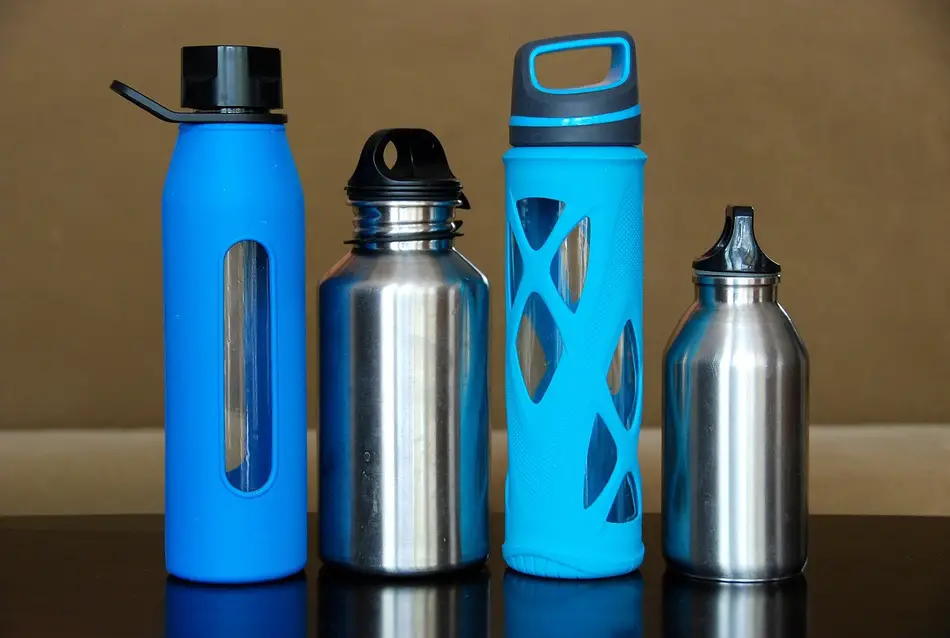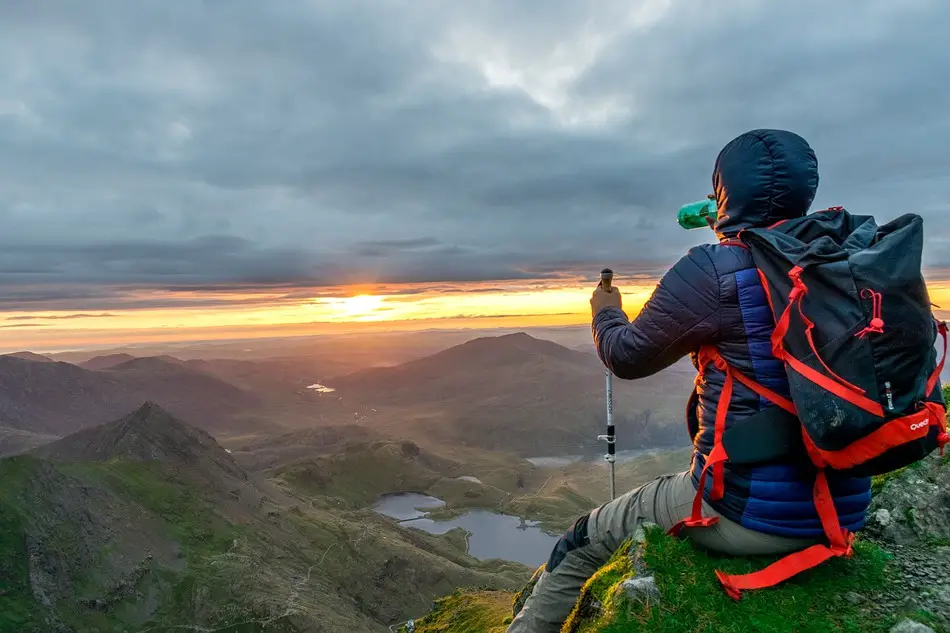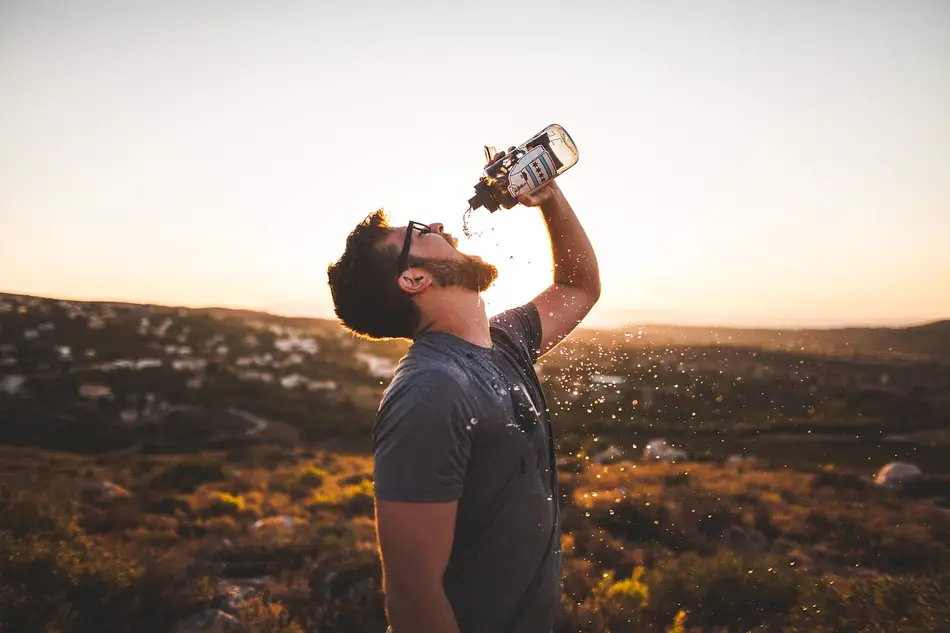It is said that a person cannot survive without water for more than 3 days. Naturally, you shouldn’t test this limit, especially if you’re hiking. Ask any experienced hiker and you will hear that hydration should be your number one priority.
So how much water should you drink when hiking? Even though a person should drink 2 liters/68 ounces a day, it is highly recommended that you drink much more during the hiking activity. Consume approximately 1 liter/34 ounces every two hours. Drink even if you’re not thirsty at the moment. Constantly sip in order to be properly hydrated.
This, however, raises additional questions. How do hiking conditions affect the required amount of water? What is the best way to carry all that water? Let’s dive into these questions in order to have the complete picture of this important subject.
Some of the topics of this article are also summarized in the following video:
How Much Water Should a Hiker Drink?
I mentioned earlier that you should drink about half a liter (17 ounces) an hour. This amount, of course, depends on the conditions of the hike. For instance, a rougher terrain forces you to exert more effort, so you can probably drink more water to compensate. High temperatures are another factor that must be taken into consideration. You can still drink 1 liter per 2 hours at moderate temperatures – but no less than that. On the other hand, a hot weather makes you sweat more and lose more liquid, so you will need to replenish it faster.
Please keep in mind that you will sweat and lose liquids even during the coldest of weathers. You might not feel hot and fool yourself into thinking that you don’t need to drink. Don’t be lulled into this misconception, keep drinking even during the autumn and winter hikes. Consider drinking something hot, you will feel warmer as well as replenish the lost water. And always remember that water is the best hydration drink for hiking, so don’t experiment with any other substitutions.
The same goes for hiking at high altitudes. The sensation of thirst is less felt at higher treks, and you will need to counteract it with more drinking.
Another aspect is the way that you drink. Don’t just chug water when you’re thirsty. Instead, sip water evenly during the entire hike. This is the best way to absorb it and stay hydrated constantly.
Always plan your hike with water on your mind. You will need to calculate the sufficient amount to take with you, you will need to have the right equipment and filters (if necessary) and you will always need to look for signs of dehydration. I do my best to clarify all these points in the rest of the article.
How Much Water to Carry While Backpacking?
Using a map, estimate the length of your planned hike. Divide the distance by an average walking speed (about 3 mph or 5 km/h). This is how many hours you will be hiking on this day. Now multiply the hours by the recommended amount of water per hour, and you have your answer. For instance, if you plan to hike for 12 miles, that’s 4 hours or 2 liters.
If you aren’t fully sure about that amount, just bring more. It’s better to carry extra water than get stranded high and dry, literally. In fact, in your very first hike, bring double the amount you’ve calculated using the method I’ve just described. This will give you a good estimate for future hikes.

How To Carry Large Amounts of Water?
There are easy, common solutions. You can even purchase any of them online for the lowest possible prices.
- Water bottle – it’s durable and widely available. You can easily store it in your backpack. However, a bottle tends to be on the heavy and bulky side.
- Collapsible bottle – an improvement to the regular bottle. They are very compact and light, although can be less durable.
- Bladder/reservoir/hydration pack – these are actually a superb solution. They come with a hose that you can sip through on the go, just as recommended. The hose on your shoulder will constantly remind you to drink. Their only disadvantage is that it’s hard to know how much water you have left, which is why many people still prefer the transparent bottles.
Any of these can serve you just fine, as long as you will always have water within your reach. If you go with the bottle and not the reservoir with a hose, make sure you can pull it out easily, without fumbling with the backpack’s zipper. Ideally you should store the bottle in the side mesh pocket of your backpack or the waist belt.
From my personal experience, the best bottle on the market is Embrava Best Sports Water Bottle. It’s large, durable, has a leak proof lid and made of eco-friendly material. With thousands of positive reviews on Amazon, this bottle is the right choice for every hiker who wants to stay hydrated at all times.
Here is a video that gives additional information on carrying water during a hike:
Can I Refill Water on the Hike?
Whichever solution from the previous list you choose, they all can be refilled on the hike. We have an extensive article on our blog that explains what water you should drink during the hike and how you can filter it. Refilling water on the go can greatly extend your hike, so plan it according to the bodies of water you can encounter along the way.
As far as filtering methods are concerned, it is understandable that not all of them fit a short hike. Unless your journey lasts for days, nobody expects you to use such time consuming methods as UV water purification, reverse osmosis, distillation, desalination, and so on. Boiling might take less time, but it requires making a camp fire, which exceeds the purpose of a simple 3-4 hours long hike.
So if there are reliable water sources on your route, consider the options that don’t add much to the time and the weight that you’re carrying. Chemical treatment by purifying tablets is quick, they weigh nothing and don’t take up place in your backpack. After you fill your bottle from the water source, drop the tablet in and enjoy purified water.
An additional option is the popular and famous LifeStraw (available on Amazon) is a great choice, it completely eliminates all the dangerous parasites and microbes from the water, such as salmonella and E. coli. LifeStraw even removes the undesirable microplastics, which unfortunately pollute a lot of water sources, lakes and streams. This excellent filter underwent meticulous testing and is very affordable. Personally, I highly recommend it.
Alternatively, you can go for a reusable bottle fitted with a special filter. Brita 20 Ounce Premium Filtering Water Bottle (on Amazon) has an effective built-in filter. The famous Brita filter improves the taste of the water while removing unnecessary chemicals. This can be your trusty companion to take anywhere, and not just to hiking, but also to work or on your long distance travels.

What Happens if I Don’t Drink Enough?
When you sweat the fluids out without adequately replenishing them, you will dehydrate. In fact, dehydration begins at the very first moment that you feel thirsty. If you don’t drink immediately to refill the lost liquids, you will begin to feel a strong thirst, dryness in mouth and your energy level will start getting lower and lower. If you don’t heed the signs, the dehydration symptoms will get even more severe: splitting headache, feeling of nausea, cramps everywhere, and overall loss of energy until you will be barely able to move on.
You can cure all of this by drinking. Check carefully how much water you sip, make sure you don’t fall off the hourly amount of half a liter or more. Also, consider drinking energy or sports drinks in addition to the regular water. They will help you to get back the lost electrolytes and carbohydrates. They leave our body when you exercise and sweat. They include potassium, sodium, magnesium, calcium – all the elements which are important to your body and your performance. Replace the electrolytes with a sports drink, and you are good to go (literally). Such a drink can be made by purchasing the necessary tablets or powders and mixing them with water.
Is It Possible to Drink Too Much Water?
No, because your body is capable of releasing unused water by triggering the urination mechanism. You are going to pee a lot while hiking, it is usual and nothing to be concerned or ashamed about. Notice the color of your urine, it’s a good hint at the current hydration level. Ideally, your pee should be clear, like the water. A yellow or brown pee and a smaller urine volume are sure signs that you must hydrate immediately.
Of course, you should never push these limits, either. In some occasions, excessive water drinking can lead to the kidneys being overloaded. As a result, a person can suffer from hyponatremia – an extremely dangerous condition of sodium dilution in blood. The symptoms are similar to dehydration (see above). The solution is simply not to drink too much, but just the right amount. You can also prevent overhydration by adding salt. You can do this by drinking electrolytes-rich sports drink, consuming a salty snack or using a salt tablet.
Remember, when you go hiking, some seasons are preferred to the others. Find out which seasons are the best to for hiking.
Related Questions
How do I keep my water cold on a hike? Your hydration packs will remain cold during the day if you previously froze some water at night. You can also freeze water in plastic bottles, but use only those with the flexible plastic. Ice expands and can tear apart any hard plastic and glass. Try hiking mostly in shade, to keep the water cool.
How can I absorb more water? If you’re not used to drinking a lot and constantly, here are a few helpful tips. Drink lukewarm water (instead of ice cold one). Add sour or sweet flavor to it. Sip water throughout the hike instead of chugging. These tricks may definitely help you drink more water that what you’re used to.
What should you drink before a hike? Before the hike, it is advisable to drink 20 to 32 ounces of water. You must start your hike pre-hydrated. Then, as you hike, drink as we have suggested earlier. Take sips constantly, even before you feel thirsty. Have another liter of water with every break for a meal.





